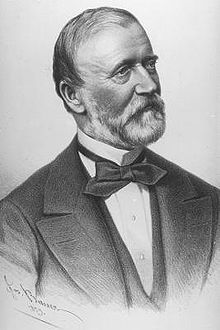Wilhelm von Engerth

Wilhelm Freiherr von Engerth (born May 26, 1814 in Pleß in Silesia ; † September 4, 1884 in Leesdorf , municipality of Baden near Vienna , Lower Austria ) was an Austrian architect and engineer . He became known as the developer of the first practical mountain locomotive . For his services he was raised to the baron status in 1875.
biography
Engerth first studied construction and then mechanical engineering in Vienna from 1834 and then went to Galicia as an architect , where he was soon entrusted with numerous commissions. He returned to Vienna to devote himself to mechanical engineering, became assistant mechanics at the Polytechnic , then a supplier professor of descriptive geometry and, in 1844, professor of mechanics and mechanical engineering at the Joanneum in Graz .
For the construction of the Semmering Railway , he designed a mountain locomotive as the world's first support-tender locomotive that met the requirements so completely that the Engerth system has been used several times since then .
Engerth was appointed technical adviser at the General Directorate for Railways in 1850, later took over the department for mechanical engineering in the Austrian Ministry of Commerce, joined the State Railway Company (StEG) as central director in 1855 and later became its general director.
In 1859 he was a member of the Customs Quete Commission and in 1860 he left the civil service. He worked on the organization of technical studies in Austria and was also a promoter of the Viennese Danube regulation . He invented the floating gate , through which the Danube Canal is protected against the ingress of ice masses. At the Vienna World Exhibition in 1873 he acted as head of the entire engineering department and, as chief engineer, was in charge of the construction of the exhibition halls. He campaigned for the Arlberg to be tunneled through . In 1874 he was appointed to the manor house of the Austrian Imperial Council and in 1875 he was promoted to the status of baron . He died on September 4, 1884 in Leesdorf. His brother was the painter Eduard von Engerth .
In 1886, Engerthstrasse (which runs in the 2nd and 20th districts) in Vienna was named after him.
Publications
- Wilhelm Engerth: The locomotive of the state railway over the Semmering: Results d. Testing d. Chain coupling to d. Prize locomotive Bavaria, discussion d. Constructions d. Wilhelm Engerth: Pictorial representations of the simple machines in isometric projection / designed by Wilhelm Engerth. Vienna 1845.
- Wilhelm Engerth: bankruptcy locomotive a. Description of several projected mountain locomotives; with an atlas of 13 copper plates. u. a lithograph Length profiles d. Semmering Railway. From: Journal of the Austrian Association of Engineers. 1853 u. 1854. (Covered: Semmering Locomotive).
- Wilhelm Engerth: cars and trucks, tender equipment, workshop equipment and tools. Drawings from the KK Austrian State Railway Company. Vienna 1857.
- Wilhelm von Engerth: The floating gate to cordon off the Vienna Danube Canal. Vienna 1884.
Awards
- Leopold Order (1854)
literature
- Constantin von Wurzbach : Engert, Erasmus Ritter . In: Biographisches Lexikon des Kaiserthums Oesterreich . 24th part. Kaiserlich-Königliche Hof- und Staatsdruckerei, Vienna 1872, p. 403 ( digitized version ).
- Eduard Frhr. von Engerth: Wilhelm Freiherr von Engerth: A memorial sheet for his 100th birthday (May 26, 1814). Vienna 1914.
- Engerth Wilhelm Frh. Von. In: Austrian Biographical Lexicon 1815–1950 (ÖBL). Volume 1, Verlag der Österreichischen Akademie der Wissenschaften, Vienna 1957, p. 252.
- Fritz Steiner: Engerth, Wilhelm Freiherr von. In: New German Biography (NDB). Volume 4, Duncker & Humblot, Berlin 1959, ISBN 3-428-00185-0 , p. 530 ( digitized version ).
Web links
- Obituary , in the Centralblatt der Bauverwaltung , No. 37, September 13, 1884, p. 382
Individual evidence
- ↑ Official part. In: Wiener Zeitung , December 27, 1854, p. 1 (online at ANNO ).
| personal data | |
|---|---|
| SURNAME | Engerth, Wilhelm von |
| ALTERNATIVE NAMES | Engerth, Wilhelm; Engerth, Wilhelm Freiherr von |
| BRIEF DESCRIPTION | Austrian architect and engineer |
| DATE OF BIRTH | May 26, 1814 |
| PLACE OF BIRTH | Pszczyna , Silesia |
| DATE OF DEATH | September 4, 1884 |
| Place of death | Leesdorf , Baden , Lower Austria |
